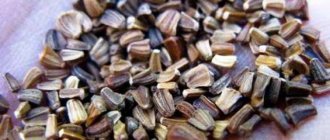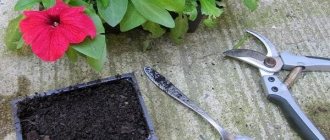07/28/2018 Michur Ivanov Garden and vegetable garden Many people dream of propagating their favorite rose bush. June-July is the best time to do this easily and simply using cuttings.
Candidate of Biological Sciences Lyudmila Uleyskaya , who worked at the Nikitsky Botanical Garden (Crimea) for more than 30 years, will tell you about all the nuances of rose cuttings.
According to the expert, rooting of cuttings should be carried out within a certain time frame:
- for greenhouse roses from a bouquet - from March to April;
- for open ground roses - from the second half of June to the end of July.
The optimal temperature for rooting is 22-25°C (sharp fluctuations should not be allowed).
Humidity – 90-100%.
Lighting – diffused sunlight.
Not all types of garden roses take cuttings well. Climbing, miniature, ground cover and many varieties of polyanthus roses and floribunda almost always take root. Hybrid teas are worse (especially varieties with dark red and yellow colors) and develop weaker than grafted ones.
So, let's look at all the stages of rose cuttings.
Rooting methods
Cuttings prepared in this way can be rooted in different ways. A lot of them. But the most effective and common:
- in water,
- in the ground,
- in potatoes
- in the package.
In water
The simplest and most common method is in water. The shoots prepared in the above way are simply placed in chilled boiled water and that’s it.
The water must be changed every couple of days. After about a month, the cuttings will have roots and can be planted in the ground. After planting, the cuttings should be covered with plastic bottles and not removed until the leaves appear.
The disadvantage of this method is the low oxygen content in the water. Therefore, be prepared for the fact that not all cuttings will take root and survive. And this method is not suitable for all varieties of roses. The result will be more successful with dwarf and ground cover species.
Rooting rose cuttings in water is the easiest way
In the soil
Rooting cuttings in the soil is a more troublesome method, but it gives a higher survival rate.
At the bottom of the pot you need to pour a layer of drainage (usually crushed stone or finely broken brick is used), then a special soil for roses. You can buy it ready-made, or you can make it yourself. To do this you need to mix:
- 40% turf land;
- 40% leaf soil;
- 20% river sand.
Approximately 5-7 cm of sand is additionally poured on top of the prepared soil mixture. When planting cuttings, you need to make sure that they are located in the ground, that is, deeper than the sand layer.
They are placed at an angle, with an oblique cut down, at a distance of three to five centimeters from one another, and the distance between the rows is at least 10 cm. Then everything is watered and covered with glass jars or plastic bottles with the bottom cut off.
Roots should appear in 25-30 days. All this time the soil must be kept moist. After the appearance of young leaves, the jars can be periodically removed to harden the plant, and then discarded altogether.
If cuttings are carried out in late spring or summer, then some gardeners plant roses directly in the garden bed. Others, even during this period, use pots first, so that weather changes and possible temperature changes do not harm the plants. Moreover, by winter, cuttings grown in the garden still need to be dug up, replanted in pots and put away in the house or cellar - otherwise the young bush will not survive the winter.
In a potato
A fairly common, proven and effective way to grow roses from cuttings at home is to root them in potatoes. The length of the cutting should be 20-25 cm. You will need medium-sized potatoes, and to prevent them from sprouting, you need to remove the eyes. The cuttings are inserted into the potatoes prepared in this way. First, use a large nail or something similar to make a shallow hole of a suitable diameter in the potato.
You need to make a hole in the potato
Then you need to take a suitable container and pour about 3-4 centimeters of sand on the bottom. Then potatoes with cuttings are placed there at a distance of 10-15 cm from each other, which can be sprinkled with a little earth. Immediately after planting, they must be watered with water and potassium permanganate (the solution should be light pink) and covered with jars. In the future, watering is carried out as needed. The plant will receive all the necessary substances and nutrition from potatoes.
Many gardeners prefer this method, as it ensures a high survival rate of cuttings at home. And later, when planting, their adaptation process is faster and more painless. Young shoots emerging from the buds will confirm that rooting was successful.
1st method
Rooting rose cuttings in a bag is also very popular. Moss is placed in a plastic bag and prepared cuttings are inserted into it. The bag is then inflated, tied tightly and hung. The condensation that will accumulate in the bag will moisten the moss and cuttings, so there is no need to think about any additional watering. The roots will appear by the end of the fourth week.
2nd method
10-12 pieces of cuttings are pre-soaked in water for 24 hours, and then wrapped in regular newspaper. The resulting package is placed in a plastic bag or bag and kept at home at a temperature of about 20 degrees.
The bag is opened weekly, the cuttings are inspected and the paper is slightly moistened. If a cutting turns black and begins to rot, it is thrown away. In this case, you need to change the paper to completely get rid of the mold.
After about half a month, roots will begin to appear.
WHICH ROSES ROOT BEST?
1st place - climbing and others like them, that is, semi-climbing 2nd place - dwarfs and polyanthas
Hybrid teas take root the worst. Nothing can be done about it! They were bred in such a way that not every daydreaming sadomaniac could get himself a bunch of pink children. How will flower tycoons survive?











